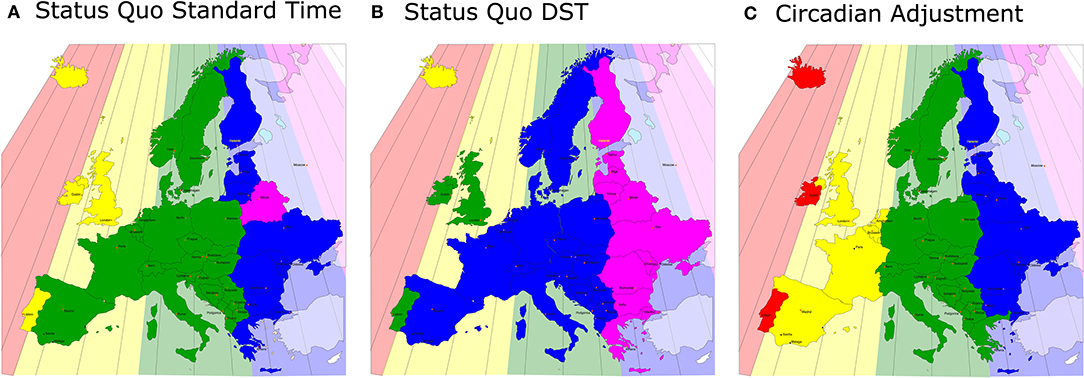Daylight Saving Time and Artificial Time Zones – A Battle Between Biological and Social Times
- 1Institute of Medical Psychology, Ludwig Maximilian University of Munich, Munich, Germany
- 2Division of Sleep and Circadian Disorders, Brigham and Women's Hospital, Harvard Medical School, Boston, MA, United States
A Corrigendum on
Daylight Saving Time and Artificial Time Zones – A Battle Between Biological and Social Times
by Roenneberg, T., Winnebeck, E. C., and Klerman, E. B. (2019). Front. Physiol. 10:944. doi: 10.3389/fphys.2019.00944
In the original article, there was a mistake in Figure 2B as published. In the map, the area of Germany was duplicated and appeared south-west of Norway. The corrected Figure 2 appears below.

Figure 2. A map of Europe equivalent to Figure 1: the actual, sun-based time zones are drawn as color-coded backgrounds and the social time zones are shown in the same (stronger) colors in front. Even under Standard Time, the western areas of the social time zones are far away from the respective eastern borders of the sun-based time zones (A), this discrepancy increases by 1 h under DST (B) (note that Iceland is on perennial DST). (C) A solution to the problem: the political borders of Europe are actually ideal for the correct, chronobiological separations into time zones, so that in no area of Europe the social clock has to be discrepant from the sun clock by more than 30 min.
The authors apologize for this error and state that this does not change the scientific conclusions of the article in any way. The original article has been updated.
Keywords: circadian, social jetlag, circadian misalignment, time zones, entrainment (light)
Citation: Roenneberg T, Winnebeck EC and Klerman EB (2019) Corrigendum: Daylight Saving Time and Artificial Time Zones – A Battle Between Biological and Social Times. Front. Physiol. 10:1177. doi: 10.3389/fphys.2019.01177
Received: 26 August 2019; Accepted: 30 August 2019;
Published: 12 September 2019.
Edited and reviewed by: Sara Montagnese, University of Padova, Italy
Copyright © 2019 Roenneberg, Winnebeck and Klerman. This is an open-access article distributed under the terms of the Creative Commons Attribution License (CC BY). The use, distribution or reproduction in other forums is permitted, provided the original author(s) and the copyright owner(s) are credited and that the original publication in this journal is cited, in accordance with accepted academic practice. No use, distribution or reproduction is permitted which does not comply with these terms.
*Correspondence: Till Roenneberg, cm9lbm5lYmVyZ0BsbXUuZGU=
 Till Roenneberg
Till Roenneberg Eva C. Winnebeck
Eva C. Winnebeck Elizabeth B. Klerman
Elizabeth B. Klerman